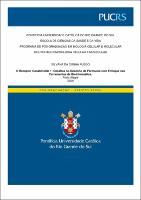| Share record |


|
Please use this identifier to cite or link to this item:
https://tede2.pucrs.br/tede2/handle/tede/9393| Document type: | Tese |
| Title: | O receptor Canabinoide 1 : desafios no desenho de fármacos com enfoque nas ferramentas da bioinformática |
| Author: | Russo, Silvana da Cunha  |
| Advisor: | Azevedo Junior, Walter Filgueira de |
| Abstract (native): | O Receptor Canabinoide 1 (CB1) é uma proteína de membrana prevalente no Sistema Nervoso Central (SNC), e teve sua estrutura cristalográfica foi recentemente resolvida e disponibilizada. Mais estudos são necessários na investigação da estrutura tridimensional dos complexos de CB1 com seus ligantes, para auxiliar no desenvolvimento de novos fármacos. Nosso objetivo aqui foi realizar simulações computacionais do CB1, focando nas suas interações com ligantes potenciais. Nós começamos com uma revisão de literatura e então descrevemos os estudos recentes sobre a estrutura cristalográfica do CB1. Nós reportamos o desenvolvimento de um novo protocolo de docking molecular para investigar ligantes em potencial contra o CB1. Nós usamos a informação estrutural para descrever as interações intermoleculares de complexos CB1-ligantes. Nós também descrevemos a metodologia de docking molecular para simular as interações do CB1 com agonistas inversos, e também com agonistas. A análise da estrutura cristalográfica e os resultados de docking molecular revelaram os resíduos responsáveis pela especificidade dos agonistas inversos e3 dos agonistas pelo CB1. A maioria das interações intermoleculares envolve resíduos hidrofóbicos, e algumas ligações de hidrogênio intermoleculares destacando a importância da exploração das interações intermoleculares no desenvolvimento de novos agonistas inversos. |
| Abstract (english): | Cannabinoid Receptor 1 (CB1) is a membrane protein prevalent in the Central Nervous System (SNC), whose crystallographic structure has recently been solved. Studies will be needed to investigate CB1 complexes with its ligands and its role in the development of new drugs. Our goal here was to carry out computational simulations of CB1, with focus on its interations with potential ligands. We start with a literature review, and then we describe recent studies on CB1 crystallographic structure. We report the development of a docking protocol to investigate potential ligands against CB1. We use this structural information to depict CB1-ligand interactions. We also describe the molecular docking method to obtain complex structures of CB1 with inverse agonists, and also with agonists. Analisis of the crystallographic structure and docking results revealed the residues responsible for the specificity of the inverse agonists and agonists for CB1. Most of the intermolecular interactions involve hydrophobic residues, and some intermolecular hydrogen bonds highlighting the importance of the exploration of intermolecular interactions in the development of novel inverse agonists. |
| Keywords: | Receptor Canabinoide Desenho de Fármacos Docking Agonista Inverso Proteína de Membrana GPCR Cannabinoid Receptor Drug Design Docking Inverse Agonist Membrane Protein GPCR |
| CNPQ Knowledge Areas: | CIENCIAS BIOLOGICAS::BIOLOGIA GERAL |
| Language: | por |
| Country: | Brasil |
| Publisher: | Pontifícia Universidade Católica do Rio Grande do Sul |
| Institution Acronym: | PUCRS |
| Department: | Escola de Ciências |
| Program: | Programa de Pós-Graduação em Biologia Celular e Molecular |
| Access type: | Acesso Aberto |
| Fulltext access restriction: | Trabalho não apresenta restrição para publicação |
| URI: | http://tede2.pucrs.br/tede2/handle/tede/9393 |
| Issue Date: | 17-Sep-2020 |
| Appears in Collections: | Programa de Pós-Graduação em Biologia Celular e Molecular |
Files in This Item:
| File | Description | Size | Format | |
|---|---|---|---|---|
| SILVANA_DA_CUNHA_RUSSO_TES.pdf | SILVANA_DA_CUNHA_RUSSO_TES | 3.32 MB | Adobe PDF |  Download/Open Preview |
Items in DSpace are protected by copyright, with all rights reserved, unless otherwise indicated.




